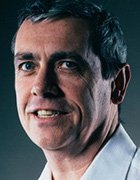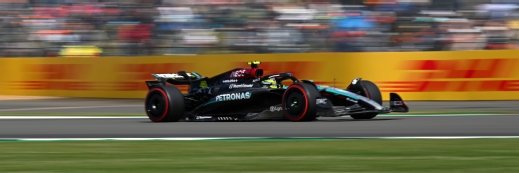
storm - stock.adobe.com
CIO interview: Graeme Hackland, CIO, Williams F1
The Formula One CIO has made big changes to IT over the last few years, helping the F1 team to move forward through cloud-driven business transformation
Graeme Hackland is a big Formula One fan and a supporter of the Williams F1 team. After joining the sport in 1997, and holding a variety of tech management roles at teams including Benetton and Lotus, he finally got the chance to join the organisation he loved in January 2014 – and he has relished every moment as CIO.
“Getting the opportunity to join Williams and seeing Frank Williams most days at the factory was just amazing,” says Hackland, referring to the founder of Williams F1, who was team principal until September 2020. But he’s done a lot more than just enjoy working with his heroes. Hackland has also made big changes to IT at the team.
“I came in to help with digital transformation,” he says. “What we’ve done as an IT group is that we’ve pivoted from zero cloud services in 2013 to 70% of all critical services now running in the cloud.
“We had support from the board and we brought in some technical partners who helped to fund some of the digital transformation programme. We switched and pivoted to the cloud and I’m really proud of that.”
Watching the world change
The transformative work that Hackland is overseeing at Williams is just the latest stage in an almost 25-year IT career in motorsport.
“I never thought F1 was an option. And even when I got the job at Benetton, I said to my father I’d do it for a couple of years and it would look good on the CV,” he says, reflecting on the “amazing” amount of tech-led change in the sport during that time.
“I remember I used to have to print out a memo for each race and put it on the engineers’ desks to tell them what data was needed to prepare for the event,” he adds. “And we had big stacks of floppy disks, and the data from each race on both cars in 1997 fitted on a floppy disk. So that’s 1.4MB – and today, we generate more than that from one car before we even get to the first corner.”
Hackland also remembers what now seems like an unsophisticated approach to IT when he made his first ever visit to a race track as an IT professional. “I flew out to Hungary with a server under my arm, installed it, and flew back the next day,” he says. “There was no IT support at the track.”
Connectivity, if it was available at all, was provided through low-power modems. That is very different from the way that data is produced and consumed by those working in the sport today.
“Now we’re streaming in real time, so within 0.1 of a second in Europe of a piece of data being generated at the track, it’s back at base,” says Hackland. “We’ve got up to 30 engineers in the UK looking at that data. And now, with Covid-19, they’re not just sitting in our base at Grove in Oxfordshire, but they’re at home – they’re all over the place.”
Using technology to transform the business
Hackland says his seven-plus years at Williams have not just involved a focus on systems and services. The behaviour of people has changed, too – and that’s thanks to his cloud-driven business transformation.
“When I first got here, I remember being copied on emails where people were requesting a database server to do some testing, and they’d be told, ‘OK, we need a couple of weeks because we’ve got to order some hardware’,” he says.
“I remember when it suddenly struck me that the cloud piece had been a success when I was copied on an email that went to one of my guys who said he needed a database server and my guy replied saying, ‘It’ll be two hours and it’s going to cost £80 a month’.”
Another successful project was when the team moved the business to Microsoft Office 365 and Outlook email, which was completed in a very short space of time not long after Hackland joined Williams. More recently, he is proud of the IT-enabled pivot to home working due to the coronavirus pandemic.

“F1 has always been about that technological race – and I think fans love that”
Graeme Hackland, Williams F1
“We logged a risk on 3 March last year saying we might have to send our colleagues home,” says Hackland. “The question was, ‘how are we going to do that and how are we going to cope from an IT perspective?’ But within a week, it was done. So I’m really proud of that. We never envisaged sending everyone home, but we wanted to make it possible for anybody to be able to work from anywhere, securely. And we made that possible.”
Hackland says the team had already started investigating how it might use a virtual desktop infrastructure to provide CAD (computer-aided design) designers with a high-quality remote-working experience. They had used CAD as the proof-of-concept project because it was perceived to be the most difficult area to move to remote working. The lessons from that project – which involved seven designers working concurrently – proved invaluable last year.
“When Covid arrived and we had to send everybody home, it took us a week to scale up – one week, and every single person was able to go home and work pretty much seamlessly,” he says. “And not all teams are able to do that. I know some never achieved that and then they had to just get people back on site as quickly as possible.”
Exploiting data for a competitive advantage
Technology has played a key role on the track, too, and Hackland says that while it’s tough getting to the top at F1, staying there is even harder. “There are so many things that you have to get right, from people to drivers and on to technology,” he says.
Hackland’s focus when he joined Williams in 2014 might have been digital transformation via cloud, mobility and collaboration, but another crucial element was data analytics. “F1 has always been about that technological race – and I think fans love that,” he says.
Read more CIO interviews
- Settling into her new role, DS Smith CIO Claire Dickson is working with the business to make strategic progress, smart, data-led changes and create a five-year digital strategy.
- Acacium’s chief product and information officer joined the healthcare specialist in the midst of the pandemic, and is responsible for data, product, business process and automation.
- Motorsport firm Envision Virgin Racing's managing director and chief technology officer wants to use data and technology to prove the benefits of electric vehicles and win “in the right way”.
One of Hackland’s key priorities over the past seven years has been to ensure that the information the team holds can be used to create a competitive advantage, something that wasn’t necessarily being exploited to the full when he arrived at Williams.
“There was data that engineers weren’t able to get to in time,” he says. “So, part of our digital transformation was that we said we will put into the hands of every engineer the data they need at the time they need it.”
That process meant taking data from a range of areas, such as aerodynamics, race engineering, manufacturing and the driver simulator. Hackland says the key to success was creating an integration layer across those areas. “That’s about the whole lifecycle of the car, whether that’s at a track or somewhere else,” he adds.
Reducing the data-feedback loop
So, how is all that data used to boost competitive performance? Hackland says simulation data is passed to manufacturing and then onto the track, before being fed back to simulation once again as part of an iterative process.
“You end up in this feedback loop,” he says. “And so we’ve put a lot of effort into automating that feedback loop and it is ongoing. We are still working on ways to make the decision-making process much quicker.”
Hackland gives an example. The team might be manufacturing a part for the car and then find out that it is superseded because trackside engineers learn something different during race testing. The aim then is to create that new and improved part and make it available for the race-day car as quickly as possible – and that’s where the data-led feedback loop comes in. “We’ve made that lifecycle much smaller and much shorter,” he says.
The team sends about 300GB of data back to base from the track each race weekend, says Hackland. Interestingly, the vast majority of that data is video rather than telemetry information.
“Video analytics has become such a big thing, both for your own car and your competitors,” he says. “The raw data coming off the car is relatively small in size, but you combine the car telemetry and the sensors – you’ll take sensor data from three or four different sensors – and turn all that into an actual piece of intelligence.
“If you combine that insight with weather data, tyre data from Pirelli, the audio of ourselves and our competitors, and then video, then that’s where you get the huge data grid.”
Making new advances
Williams F1’s reliance on technology and data will only increase going forward. The racing team was acquired by Dorilton Capital last August, and Sir Frank Williams and Claire Williams, the former deputy team principal, stepped down from their management roles the following month. CEO Jost Capito recently took on the role of team principal.
“There’s going to be investment into all aspects of what we do,” says Hackland, referring to the continuing plans for transformation. “Our owners want us to go about that business quietly and to just get on with it, which is what we’re doing.”
One likely area of investment is the introduction of more automation within manufacturing. Hackland says the team is investigating the potential of artificial intelligence and quantum computing, and is looking to do some “interesting things” around what his organisation calls advanced digital manufacturing, or what others might refer to as 3D printing.
“We are already producing some parts of the car via 3D printing – more of the car will be printed, for sure,” he says. “Metals that we’ve been talking about for so long are finally a reality, so you’ll be able to print some of the metal parts to put on the car. So we’re really into that and there will continue to be significant changes because that’s the nature of F1.”










